Bathroom Flooring Options: A Complete Guide
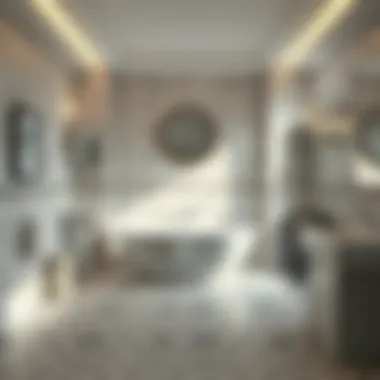

Intro
When it comes to revamping bathrooms, flooring choices might just be the most pivotal. The bathroom isn't just a functional space; it's a sanctuary for self-care and relaxation. So, selecting the right flooring that marries durability, moisture resistance, and aesthetics becomes paramount. With a myriad of materials out there—from stylish tile to cozy vinyl and elegant natural stone—finding the perfect match for your style and needs can feel like searching for a needle in a haystack.
Many homeowners find themselves grappling with choices, questioning what will stand the test of time while still looking smashing. Each type of flooring has its own character and charm, and understanding these differences is vital. Moreover, trends are forever evolving; what’s en vogue today might be passé tomorrow. Therefore, this guide aims to bridge the gap between choice and implementation, exploring the essentials that will help you make educated decisions about your bathroom flooring.
Be it modern minimalism that emphasizes clean lines and stark contrasts, or a cozy rustic vibe that brings a slice of nature indoors, we’ll delve into it all. We will also chat about trending color palettes, discussing how shades like calming neutrals and bold accents can transform a minor space into a statement one. So, grab a cup of coffee, and let’s get into the nuts and bolts of finding the ideal flooring that speaks to your unique vision.
Understanding the Importance of Bathroom Flooring
When it comes to bathrooms, flooring often gets overlooked in favor of fancier fixtures or fancy paint jobs. However, choosing the right flooring is crucial; it sets the stage not just for aesthetics but also for functionality and safety. Your bathroom floor is subjected to varying levels of moisture, foot traffic, and impacts every single day. Failure to select appropriate flooring can lead to issues that could cost you time and money down the line. Here’s why it’s essential to approach your bathroom flooring choice with care.
Functionality and Practicality
Bathroom flooring must be designed to handle moisture—this is a non-negotiable feature. Whether you find yourself hopping out of the shower or dealing with everyday splashes, a waterproof flooring option makes all the difference. You wouldn’t want your beautiful wood flooring to warp or rot due to a bit of humidity, would you? That said, materials like ceramic tiles or vinyl are popular for a reason. They offer practical solutions while requiring minimal upkeep. In addition to being moisture-resistant, they are easy to clean, ensuring that time spent scrubbing floors can be kept to a minimum.
"A well-chosen bathroom floor not only withstands the test of moisture but also enhances your daily routine."
There is also the question of comfort. Think about early mornings when you step onto that cold tile. Not exactly the warm welcome one would want, right? Some flooring options can have heating installed underneath, making every step a snuggly experience. Ultimately, functionality meets practicality in flooring choices that hold up against wear, tear, and ordinary temperature fluctuations of your bathroom environment.
Aesthetic Contributions
They say a room isn't complete until it has the right floor; this can be more than just a pretty saying. The flooring sets the mood and character of your bathroom. Are you leaning towards a spa-like sanctuary or possibly something more modern and sleek? Whatever your taste, various materials offer styles that can dramatically alter the vibe of the space. From patterned tiles to textured vinyl, the choices can seem endless.
For example, natural stone offers timeless elegance while ceramic options can mimic the same aesthetic without the hefty price tag. The colors you choose can also create illusions of space or intimacy. Pale shades may open up the room, while darker hues add warmth and coziness. After all, it’s your haven—shouldn’t it look the part?
Safety Considerations
While aesthetic choices are fun to explore, safety should always sit at the top of the priority list. Wet floors are a leading cause of slip and fall accidents in the home, particularly in bathrooms. Hence, the right flooring should not just look good but also provide a non-slip surface.
Finding materials that strike a balance between style and safety is key. Textured tiles or vinyl with enhanced grip can prevent those unfortunate slips. Furthermore, choosing the right finish can keep the floor providing traction while adhering to your design needs. Generally speaking, matte finishes offer more grip than glossy counterparts. So, ensure that beauty doesn’t compromise safety in your choice of flooring; the best flooring options should give you peace of mind along with style.
When you consider functionality, aesthetics, and safety all together, it’s clear how vital flooring is in your bathroom planning. With the right information in hand, making a choice that complements your life and your style can be a satisfying experience.
Key Characteristics for Bathroom Flooring
Selecting the right flooring for a bathroom is crucial, as this space is subjected to unique conditions compared to other rooms. It’s not just about looks; factors such as moisture resistance, durability, and comfort play significant roles in ensuring that your flooring can withstand the trials of daily use while still looking good as new. This section outlines these key characteristics in detail, providing insights that can help housewives and homeowners make informed decisions that suit their lifestyles and preferences.
Moisture Resistance
When it comes to bathroom flooring, moisture is an undeniable adversary. Water spills, humidity from showers, and the occasional splashes from the sink can create a hostile environment for certain flooring materials. Therefore, moisture resistance should be your top priority. Materials like ceramic and porcelain tiles are excellent choices due to their impermeable surfaces. On the flip side, you might find that hardwood floors, while aesthetically pleasing, are particularly vulnerable to water damage, leading to warping and mold growth.
You can also consider vinyl flooring, known for its high water resistance, making it a favorite among homeowners. Think of bathroom flooring as a shield against the elements—choose materials that won't buckle under pressure.
"Choosing the right flooring material is akin to selecting the right armor for battle; it must withstand the tests it will face."
Durability and Longevity
Next up is durability and longevity. Bathrooms are among the most trafficked spaces in a home, and the flooring needs to hold up against daily wear and tear. After all, who wants to replace their floor every few years? Look for materials that can stand the test of time.
For instance, natural stone tiles are known for their durability, though they may require more maintenance to keep them looking fresh and free of stains. Moreover, porcelain tiles are not only moisture-resistant; they also score high on durability. Vinyl flooring comes in a rainbow of designs while also being tough enough to resist scratching and dents, making it an appealing option for busy households.
Here are some materials that stand strong:
- Ceramic tiles: tough and long-lasting
- Vinyl: resilient with stylish options
- Stone tiles: natural and robust
The right choice will save you money and hassle in the long run.
Comfort and Warmth
Finally, when selecting flooring, comfort and warmth shouldn't be overlooked. Stepping out of a warm shower onto cold tiles can be a jarring experience. Think about the sensation you want when you set foot on your bathroom floor. Some materials can feel uncomfortably chilly underfoot, especially during winter months.
Consider heated flooring systems if you're leaning toward tile. While it may not be the most common bathroom feature, it’s a luxury that is growing in popularity. Vinyl flooring, thanks to its soft texture, often feels more forgiving underfoot, providing a cozy sensation that can be welcoming.
You may also want to analyze the thickness of the material. Thicker materials tend to absorb more heat, while thin surfaces can feel like walking on ice. Soft area rugs can also alleviate that cold tile feel, adding a touch of warmth and comfort.
As you think about flooring options, keep these key characteristics in mind: moisture resistance, durability, and comfort. Selecting the right materials will not only enhance the functionality of your bathroom but also create a pleasant environment that you will appreciate for years to come.
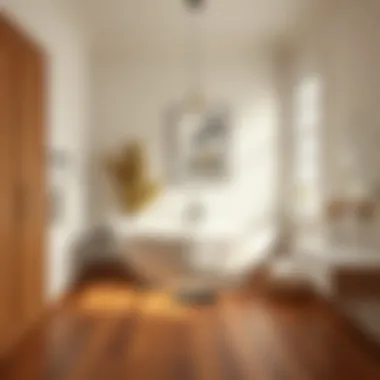
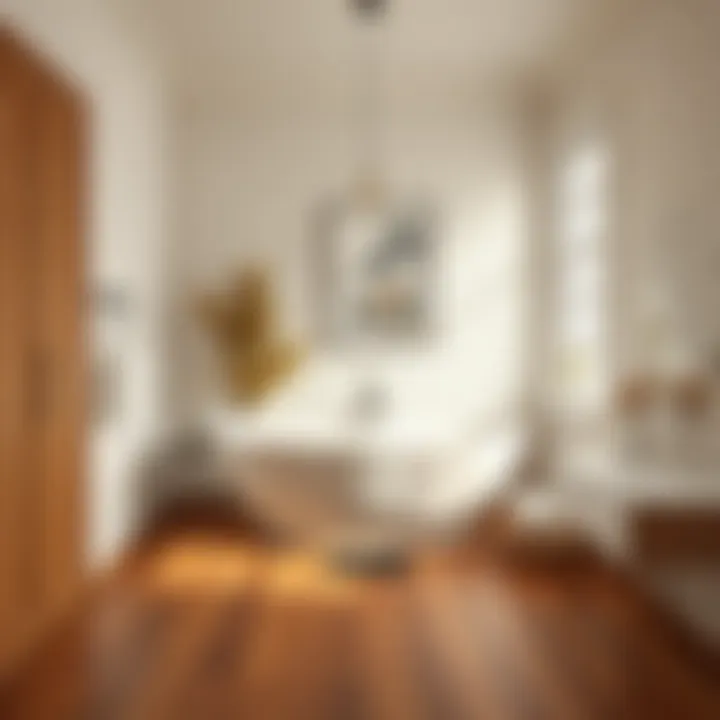
Popular Flooring Materials for Bathrooms
When it comes to choosing flooring materials for bathrooms, it’s not just about aesthetics; it’s also about functionality. The bathroom is a space exposed to moisture and often sees heavy foot traffic, making the choice of flooring even more crucial. A flooring option must withstand humidity while still looking great and being easy to maintain. Here, we’ll explore four popular flooring materials—each with unique advantages and considerations.
Ceramic and Porcelain Tiles
Varieties and Patterns
Ceramic and porcelain tiles come in a range of colors, shapes, and patterns that can complement any bathroom style. From traditional squares to modern mosaics, the choices are endless. The beauty of these tiles lies in their ability to mimic other materials, like natural stone or wood, thus offering versatility in design. The textured surface on some tiles can add depth to the space, while glossy finishes create a sleek look. They are generally favored for their durability and easy maintenance.
Installation Techniques
Installation of ceramic and porcelain tiles can be straightforward for those experienced, yet tricky for the novice. Tile requires a well-prepped subfloor and precise cuts. Mortar is spread over the area, followed by careful placement of each tile. The unique feature of tiles is grout lines that can be colors to match or contrast for aesthetic effects. However, improper installation may lead to cracking in the tiles if not laid correctly, which results in costly repairs down the line.
Maintenance Practices
Maintaining ceramic and porcelain tiles is relatively easy. Regular sweeping and mopping can keep them looking new. Grout can stain and needs occasional deep cleaning. Sealing the grout lines helps prevent dirt from settling in, making cleaning a less daunting task. While these tiles offer durability and low maintenance, one has to be cautious, as glazed tiles can become slippery when wet.
Vinyl Flooring
Types of Vinyl
Vinyl flooring comes in numerous types, including sheet vinyl, vinyl tiles, and luxury vinyl planks (LVP). Each option has its benefits. Sheet vinyl tends to be more water-resistant, while vinyl tiles can be replaced easily if damaged. Luxury vinyl, with its superior appearance and texture, often resembles wood or stone without the hefty price tag. The flexibility of design, coupled with water-resistant properties, makes vinyl a popular choice for many homeowners.
Installation Methods
Installing vinyl flooring can be less complex compared to tiles. Many homeowners opt for click-lock installation for luxury vinyl planks, which allows for easy, floating installation over existing floors. Sheet vinyl often requires adhesive, needing careful measurement to avoid excess waste. However, improper cutting or alignment can lead to unsightly seams that become dirt traps, making accuracy key when laying down vinyl.
Benefits and Drawbacks
Vinyl flooring is known for its affordability and various styles. It can be softer underfoot compared to tile, offering modest comfort. However, while vinyl holds up well against moisture, it may not be as durable under heavy impacts as hard surfaces like tile or stone, prone to scratches and dents over time.
Natural Stone Options
Granite
Granite tiles offer an elegant, natural look contributing to any bathroom design. They can withstand moisture yet are also sealed to prevent stains and water absorption. The unique specks and patterns in each piece ensure that no two tiles are alike, offering a distinctive charm. However, the weight of granite means that a sturdy subfloor is a must, and the cost can be on the higher side.
Marble
If luxury is what you seek, marble flooring makes a statement. Its stunning, veined appearance adds sophistication, elevating the entire space. However, it is important to note that marble is more porous than granite and requires regular sealing to maintain its beauty. Care must be taken as it can be slippery, posing a hazard when wet.
Slate
Slate tiles bring a textured, earthy quality to bathrooms. The unique layers in slate provide resistance to water and make it ideal for areas often exposed to spills. Yet, it can vary in thickness and have rough edges that may require additional care during installation. While durable, its density can feel cold underfoot, thus it might be wise to consider heating options beneath.
Laminate Flooring
Suitability for Bathrooms
While traditionally thought to be less suitable for bathrooms, advancements in laminate technology have changed the game. Moisture-resistant laminate is now available, making it a feasible option for bathrooms. This material offers visual appeal similar to hardwood without the price tag, albeit the longevity can be less than that of tiles or natural stones. It’s lightweight, easy to cut, and can be installed over a variety of substrates, making it versatile.
Styles and Designs
Laminate flooring comes in a wide range of styles, replicating the look of wood, tile, or even stone. Whether your bathroom has a modern or rustic appeal, there’s a laminate that fits. A unique feature is the ability to choose designs that are easy to coordinate with existing elements in your space. However, the visual appeal comes with a trade-off on the realistic feel of wood or stone.
Installation Insights
Installation of laminate is generally straightforward, with many options featuring a click-lock design that allows for easy DIY installation. There's no need for glue or nails, reducing installation time. However, if not handled carefully, the moisture from bath environments can seep in at the edges, causing issues over time. Proper sealing is essential to extend its life.
Design Considerations for Bathroom Flooring
When it comes to selecting flooring for a bathroom, design considerations go beyond just aesthetics. The right choices can completely transform the vibe of this often-utilitarian space, blending function with personal style. Factors like color schemes, patterns, material combinations, and the overall visual flow are critical to achieving a balanced and appealing environment. Let's explore these elements in detail.
Color Schemes and Patterns
Choosing the right color scheme is pivotal for setting the tone of your bathroom. Light colors can make a small space feel expansive, while darker shades can add a touch of sophistication. For example, a pale blue or soft gray can evoke a calming atmosphere, reminiscent of tranquil waters, whereas deep navy brings a richness that’s undeniably elegant.
Patterns play a crucial role, too. You can opt for bold geometric shapes to create a modern feel or delicate floral designs for a more traditional look. Here are a few pointers regarding color and pattern:


- Consider the lighting: Natural versus artificial light can dramatically alter how colors appear.
- Reflect your personality: Use colors that resonate with your taste and style – don’t shy away from expressing yourself!
- Balance patterns wisely: If you decide on patterned tiles, pairing them with complementary solid colors can prevent the visual chaos.
Combining Materials
The beauty of bathroom flooring lies in the ability to combine various materials to create a unique look. Different textures and finishes can add depth and interest to your space. For instance, think about contrasting smooth ceramic tiles with textured natural stone, which could enhance both visual and physical dynamics.
- Durability aspects: When combining materials, always keep in mind their durability in moisture-laden environments.
- Complementary colors: Make certain that the colors of the different materials harmonize well. This ensures cohesion in design.
- Flow and functionality: The transition between different materials should feel seamless. Consider using transition strips or thresholds for sleek edges.
Creating Visual Flow
Visual flow in a bathroom creates a sense of harmony and unity. The idea is to guide the eye smoothly through the space, so choosing flooring that leads from one area to another is key. Here are strategies to enhance the visual flow:
- Consistent material use: If you're working with smaller spaces, using the same material from floor to wall can elevate that sense of continuity that binds the area together.
- Strategic layout: Think about how the layout of your fixtures, such as sinks, toilets, and showers, interacts with your flooring choice. A logical arrangement helps maintain flow.
- Transitional patterns: Incorporate running patterns or lines that direct attention, such as diagonal tiling or planks that run toward a focal point.
Tip: When setting the scene for a bathroom, remember that the right combination of color, texture, and layout can create a space that both looks good and feels good.
Understanding these design considerations not only adds personal flavor to your home but ensures a practical living space suited for everyday use.
Installation Tips and Considerations
Proper installation of bathroom flooring is not just a matter of aesthetics; it is about creating a functional and lasting surface that can withstand the unique challenges of bathroom conditions. As you venture into selecting and installing new flooring, it's essential to pay attention to the nuances of the installation process. Not only can a well-executed installation enhance the overall look of your space, but it also significantly contributes to the longevity and performance of the flooring material itself. So let’s dive into some crucial tips.
Pre-Installation Preparation
Before you even think about laying down tiles or vinyl, take a step back and evaluate your space. Every project begins with a well-thought-out plan. Here are some steps to consider:
- Assess the Existing Floor: Check for moisture damage, cracks or uneven surfaces. Address these issues first to ensure a sturdy foundation.
- Choose the Right Material: Different flooring materials come with varying installation methods. For instance, ceramic tile requires a different approach than vinyl plank.
- Gather Your Tools: Stock up on necessary tools like a tile cutter, leveling compound, trowel, and measuring tape. Having everything on hand avoids costly downtime.
- Consider a Coupon Fortune: Some stores might offer discounts for materials if you buy in bulk. Keep an eye out for offers!
Taking these steps will save you time and headaches later on.
Hiring Professionals vs. DIY
The debate is as old as time: should you tackle a flooring installation as a DIY project or hire professionals? Each option has its pros and cons, so let’s break them down.
Hiring Professionals
- Experience Matters: Professionals have the skills to handle unexpected challenges during installation.
- Quality Assurance: They ensure each tile or plank is properly fitted, avoiding future issues like uneven flooring or water damage.
- Time-Saving: A team of experts can complete the installation much quicker than a novice could.
DIY Approach
- Cost-Effective: Doing it yourself can save you significant labor costs.
- Learning Experience: If you enjoy home improvement projects, this can be a fulfilling way to learn and expand your skill set.
- Flexibility: You can work on your own time and pace, making it easier to fit around your schedule.
Ultimately, the choice depends on your skill level, budget, and time constraints. If you feel unsure, seeking professional help might be your best bet.
Ensuring Proper Drainage
When it comes to bathrooms, ensuring proper drainage is as important as choosing the right flooring. Poor drainage can lead to serious problems like mold and damage, negating any aesthetic improvements you made. Here are some considerations:
- Slope the Floor Correctly: When installing new flooring, ensure it slopes towards the drain. This angle might seem small but makes a world of difference in preventing water pooling.
- Utilize Water-Resistant Materials: Flooring materials like ceramic and vinyl often have water-resistant properties. Ensuring your materials are suitable for moisture-prone areas will prolong their lifespan.
- Check Seals and Grouts: After installation, make sure that seals and grouts are intact. These are your first line of defense against leaks.
"A stitch in time saves nine" when it comes to proper drainage in bathrooms. Little checks today can save big headaches tomorrow.
By following these installation tips and paying attention to proactive measures, not only will you enjoy the visual appeal of your new bathroom flooring, but you’ll also enhance its functionality and prolong its life. This thorough prep work is where any successful flooring project begins.
Maintenance and Care of Bathroom Flooring
Maintaining bathroom flooring is just as crucial as selecting the right materials during the initial stages of a bathroom project. The daily exposure to moisture, cleaning products, and foot traffic can take a toll on your flooring, irrespective of its type. This section delves into the importance of a regular maintenance routine, which not only keeps your flooring looking pristine but also extends its lifespan significantly. By understanding what is involved in proper upkeep, homeowners can enjoy both the beauty and functionality of their chosen bathroom floors for years to come.
Cleaning Routines
A consistent cleaning routine is essential for preserving the appearance and durability of bathroom flooring. Sweeping or vacuuming regularly is the first line of defense against dirt and debris, which can scratch or dull surfaces over time. Depending on the type of flooring—be it tile, vinyl, or natural stone—specific cleaning methods should be adopted. For instance:
- Vinyl Flooring: Use a damp mop and a cleaning solution recommended by the manufacturer. Avoid harsh chemicals that can cause discoloration.
- Ceramic and Porcelain Tiles: These can typically handle a more robust approach, including using a soft-bristle brush for grout lines and a mild disinfectant for a thorough cleaning.
- Natural Stone: Gentle cleaning solutions specifically designed for stone are crucial, as acidic cleaners can etch the surface.
Establishing a routine that includes spot cleaning spills immediately can preserve the surface finishes, preventing stains and unsightly spots from setting in. Choosing the right products makes a world of difference in the overall durability of the materials.
Addressing Wear and Tear
Regardless of how diligent you are, wear and tear are inevitable over time. Scratches, chips, or discoloration can occur, but knowing how to address these issues can prevent them from becoming bigger problems. It's important to regularly inspect your floors for these signs:
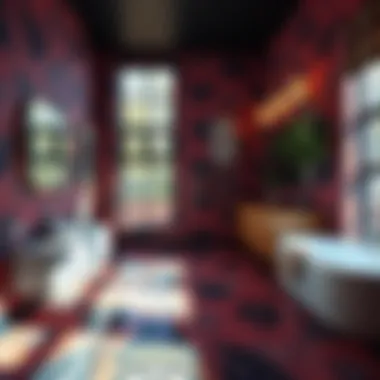
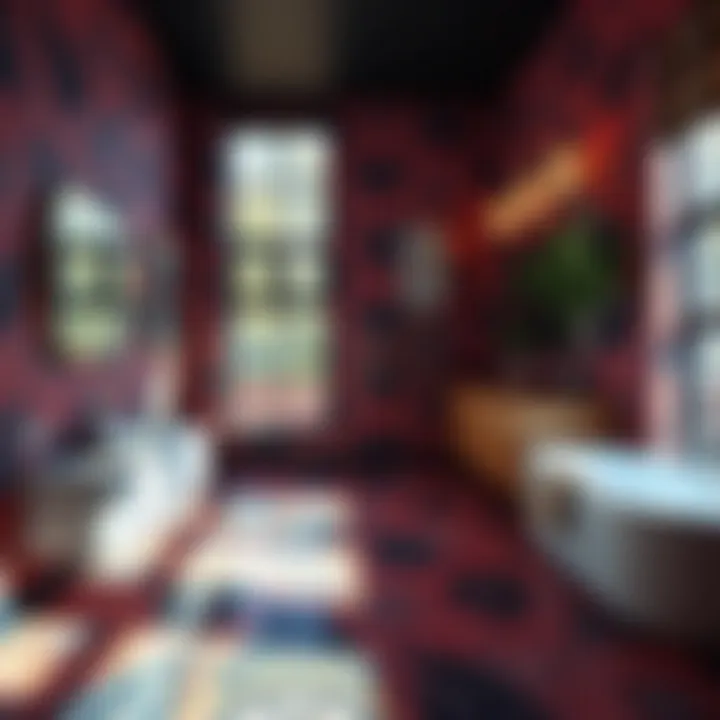
- Chips and Cracks: For tile, applying a suitable epoxy used for minor repairs can effectively seal small gaps.
- Scratches: There are specific products designed to fill in scratches on laminate or vinyl. In some cases, using a color-matching marker can disguise minor blemishes.
- Grout Issues: For tiled surfaces, keep an eye on the grout lines. Regrouting may become necessary as the original grout wears down or becomes stained, effectively refreshing the floor's look.
A proactive approach can save you the headache and expense of a full floor replacement down the line.
Long-term Upkeep Strategies
Planning for long-term maintenance can save you time and money in the future. Here are some strategies that can be implemented for various flooring types:
- Routine Maintenance Checks: Schedule regular evaluations to ensure your flooring remains intact and that no issue goes unnoticed.
- Seasonal Deep Cleaning: Once or twice a year, consider a deep clean, including steam cleaning for tiles and professional services for natural stone surfaces. This helps in removing built-up grime that regular cleaning might miss.
- Protective Measures: Use mats and rugs strategically placed in high-traffic areas to protect floors from wear. Additionally, ensure that spills are cleaned up swiftly to prevent staining.
Overall, understanding how to care for bathroom flooring not only preserves its aesthetic but also enhances its performance. This knowledge empowers homeowners to potentially save on future repairs and renovations while ensuring that their bathrooms continue to provide comfort and beauty for years to come.
Trends in Bathroom Flooring Design
In the ever-evolving world of interior design, bathroom flooring trends reflect not only personal style but also broader shifts in consumer preferences and values. Homeowners today place a premium on flooring that harmonizes functionality with beauty, paving the way for designs that make a statement while also meeting practical needs. Understanding these trends can help you make informed choices that resonate with your tastes and enhance the value of your home.
Sustainable Materials
With increasing awareness about climate change and the environment, sustainable materials are gaining traction in bathroom flooring design. Products like bamboo, cork, and recycled tiles are becoming favorites for their minimal ecological footprint. Bamboo, for instance, is a grass that grows quickly and can be harvested sustainably, making it an eco-friendly option.
Additionally, cork is not only renewable but also serves well in terms of comfort and insulation, keeping floors warm while being naturally water-resistant. Opting for these materials reduces waste and promotes a healthier home environment.
It's a win-win; choosing sustainability often plays a part in the chic modern aesthetic, allowing homeowners to contribute positively without sacrificing style.
Textured Finishes
Texture adds depth and interest to bathroom flooring, and right now, textured finishes are in vogue. Whether it’s a matte stone tile or a tactile vinyl with raised patterns, these finishes create a dynamic atmosphere. On top of that, they can enhance safety by improving slip resistance, which is crucial in wet areas.
Textured surfaces come in various designs, from rough slate to embossed patterns that mimic natural elements—these options enable homeowners to strike a balance between stylish and practical.
"Incorporating textured flooring can transform the mundane into an experience. It invites touch and interaction in a space often overlooked."
Bold Color Choices
Gone are the days of safe, neutral tones dominating bathroom floors. Now, bold color choices can inject personality and flair into these spaces. Vibrant blues, deep greens, and even striking reds are making an appearance, providing a backdrop that brings life to otherwise standard setups.
When considering color, be mindful of how it pairs with other elements in the bathroom. For example, a rich navy tile can contrast beautifully with white cabinetry, creating a modern, fresh look.
Homeowners are increasingly realizing that their bathroom can be a canvas, not just a functional space, allowing them to express themselves and make their living area feel unique and inviting.
Budgeting for Bathroom Flooring Projects
When it comes to bathroom flooring, hitting the right balance between quality and budget is paramount. Let’s face it, a bathroom remodel isn’t just about aesthetics; it’s also a hefty investment in your home’s value. Understanding how to budget properly for flooring projects can save you from those nasty financial surprises down the line, ensuring you achieve your desired look without draining your bank account.
Cost Analysis of Materials
Before diving into any flooring project, it’s vital to analyze the cost of materials. Each type of flooring comes with its own set of price tags:
- Ceramic and Porcelain Tiles: Typically more affordable, with prices ranging from $1 to $15 per square foot. When considering intricate designs or high-end brands, this can escalate.
- Vinyl Flooring: A budget-friendly option that often falls between $2 and $7 per square foot. This is especially appealing for homeowners who want the look of wood or stone at a fraction of the cost.
- Natural Stone: While stunning, materials like marble or granite can be quite costly, often running from $5 to $50 or more per square foot.
- Laminate: Generally priced between $1 to $5, laminate offers a suitable alternative for those wanting a realistic wood look without the cost associated with real hardwood.
Ultimately, calculating the total material cost before you commit will help set realistic expectations.
Estimating Installation Costs
Installation prices can also vary wildly, depending on complexity and labor required. It’s essential to budget for this aspect as well, as it can often be the hidden culprit in budget blowouts. Here’s what to consider:
- Professional Installation: Hiring a contractor for installation can cost anywhere between $1 to $3 per square foot. This option typically provides peace of mind and quality workmanship.
- DIY Installation: If you have some handy skills, tackling the project yourself can save a pretty penny. However, don't overlook potential missteps that could lead to costly repairs down the line.
- Additional Costs: Don’t forget to factor in expenses for underlayment, adhesives, or even flooring removal. These hidden costs can tip your budget over if you’re not cautious.
Financing Options
Budget constraints shouldn’t prevent you from achieving your dream bathroom. Understanding your financing options can really widen the door for ambitious projects:
- Home Improvement Loans: Many banks offer specialized loans for home renovations, which can help spread out your financing over several years.
- Credit Cards: Utilizing a credit card with favorable terms can serve as a short-term solution for smaller projects. Just be cautious about accumulating debt and high-interest rates.
- In-House Financing: Some flooring retailers provide financing directly through their shops, allowing you to pay monthly. This can be a convenient way to manage cash flow without breaking the bank upfront.
"Always aim to budget wisely; sometimes the best-looking floor is the one that won’t keep you awake at night worrying about bills."
Final Thoughts on Bathroom Flooring Choices
Choosing the right flooring for your bathroom is not merely a matter of aesthetics or following the latest trends. It embodies a confluence of practicality, safety, and personal preference. In the closing analysis of flooring options, it becomes clear that one must weigh several critical elements. Whether you are embarking on a full renovation or looking to make small adjustments, understanding your specific needs will guide your decision-making process.
Evaluating Personal Needs
Before diving headfirst into a selection of materials, assessing one's specific needs is essential. Ask yourself a series of questions: How many people use this bathroom? How often do spills occur? Do you prefer ease of cleaning over elegance? If the bathroom in question serves multiple family members, a durable and low-maintenance flooring option may be your best bet. Here are some key considerations:
- Traffic Level: If your bathroom sees more traffic than a busy highway during rush hour, it's wise to opt for tough materials like porcelain tiles or high-quality vinyl.
- Usage Patterns: Homes with kids might benefit from softer surfaces that also provide safety—consider materials that are less slippery and thus reduce fall risks.
- Personal Style: Maybe you fancy a spa-like experience with natural stone, or prefer the cozy vibe of wood. Whatever the case, your choice should reflect your taste and elevate your space.
Evaluating personal needs ensures that you do not compromise comfort for budget or beauty for durability. Ultimately, flooring should not only fulfill its function but also contribute to the overall serenity of your personal sanctuary.
The Impact of Flooring on Overall Bathroom Design
Your choice in flooring will serve as a backbone to your bathroom's design. It's not just about picking a color or a pattern; flooring sets the mood. Consider how the floor complements the cabinets, countertops, and fixtures. Think of your flooring as the canvas where the artistry of your overall design unfolds.
Here are some of the nuanced impacts that flooring can have:
- Color and Pattern Coordination: Darker tiles can create a dramatic effect, while lighter shades may expand the visual space. A patterned tile can also serve as a focal point that draws the eye, enhancing the room's aesthetic appeal.
- Material Contrast: Mixing materials can break monotony and add depth to your design. Imagine a sleek modern bathroom with sleek ceramic tiles juxtaposed against warmed wooden accents.
- Creating a Cohesive Flow: Flooring is the common ground in your home’s design. From the bathroom to adjacent rooms, maintaining a flow can harmonize your space and provide a seamless transition. This is especially effective when using similar materials or colors.















